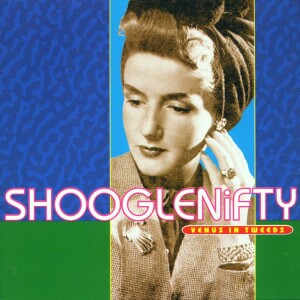 Chuck Lipsig penned this review.
Chuck Lipsig penned this review.
Shooglenifty’s Venus in Tweeds starts out with “The Pipe Tunes” (John McKenzie’s Fancy/ The Kitchen Piper); never mind that there are no pipers in this band. A minute-long intro gets a nice beat going, courtesy of James Mackintosh on drums, and has some nice banjo work in it by Garry Finlayson. At one minute, Iain MacLeod gets the mandolin going for a minute of a hot reel. At the two minute mark, the band backs off into a peaceful bridge, with Malcolm Crosbie’s guitar taking the lead and a little ambient space noise thrown in. The tune morphs into a more country sound at the two-and-a-half minute mark, followed by another mandolin solo. At three minutes, the tune is taken over by the fiddler, Angus Grant, who takes it home through some both straight-forward and syncopated sections. Throughout, Conrad Ivitsky’s bass provides a strong foundation. When the piece suddenly ends at almost the five minute mark, it sounds like the band had to stop there or keep on playing until they collapsed.
OK, I’m not going to go through every tune in quite so much detail, but this defines the Shooglenifty style. The band claims that the name means “To shimmy in a free fashion” and they do so very well. Primarily instrumental — what vocals there are are wordless tones — traditional and traditional-style tunes are played, usually over a high energy, rock, jazz, or blues foundation. Often, high-powered sections are bridged with calmer, mellower passages. No one member of the band stands out as the leader; rather, the tune smoothly changes from one musician to another. The result is satisfying far more often than not.

“Horace” has a similar intro before taking off with “The Garmian Television Jig,” which seems, at first, to be sliding between a slip jig and regular jig (or maybe that’s slipping between a slide jig and a — oh, never mind). There’s an interesting bridge between “Horace Shaw of Highfield” and “The Old Woman’s Dance,” in which a fiddle smoothly transforms into the sound of a train chuffing, then into the band doing a convincing imitation of train, then back to the train sounds, and finally into a new tune (though the train shows up faintly in there, as well). That’s one heck of an energetic old woman, by the way.
“The Point Road” is something different, half-jig and half-blues, with some literally finger-snapping rhythm. If the French had won the French and Indian wars and forced the Scots settlers in eastern Canada to move down south, the music that developed instead of zydeco might sound a lot like this. The title track, “Venus in Tweeds,” has a strong mid-Eastern feel to it, with some dream-like guitar and vocal bridges. If Turkey had held out against the British in W.W.I, the music that might have… Never mind. The reviewer is in a very silly mood tonight.
“Waiting for Conrad” starts out, appropriately enough, with bassist Conrad Ivitsky in the lead. This tune has a great swaggering feel to it. Patti and I are trying to figure out if the bass-line was used for a certain Volkswagen commercial — which is not a complaint. The percussion — which sounds like metal being struck — is very effective. The tune ends with what sound like water pipes in a tunnel, then makes a transition to “Two Fifty to Vigo,” which starts out slow and mysterious, then transforms into a beautiful, quietly joyful tune. The tune alternates between spooky, with faint whispering in the background, and joyful. The difference in feels works surprisingly well together, making each part more intense than perhaps they would have on their own.
“Paranoia” starts out with a jerky bass-line and some sound effects that do, indeed, sound paranoid, before cutting into a nice pair of reels by MacLeod, “Paranoia” and “Flapper’s Reel.” This is interrupted by another bout of musical paranoia towards the end — or maybe it’s just a whining violin — that finally dissolves into a fiddle having a psychological breakdown. “Buying a Blanket” (this is definitely a slip jig) is paired with “Murphy the Mousecatcher.” This was written by the band’s fiddler, and it gives his fiddle a chance to wail, rather than whine.
“The Tammienoree” (with “Leo Elsey’s Reel” and “Les Reel des Voyageurs”) is the most straightforward arrangement on this CD. The transitions from lead instrument to lead instrument are very nice in this set. Garry Finlayson’s banjo playing is wonderful. The set sounds several times like it’s about to end, only to have the band keep going. By the end, several of them are singing along and as the sound fades out, you can here laughter and someone calling out “We were having fun!” So was I, just listening to it. Again, I have the feeling that the band would still be playing this, six years later, if physically possible.
The last track of Venus in Tweeds is a remix of “The Point Road” (called “Joiner’s Mix” on the liner notes). It features heavy bass and Malcolm Crosbie whistling the tune. It’s an impressive bit of whistling, especially the bird calls at the end.
A Whisky Kiss picks up where Venus in Tweeds leaves off. There may be a slightly more diverse style, or it may be my imagination. In any case, it’s still hard-driving arrangements of traditional style tunes.
“Da Eye Wifey” starts out with quiet whistling and what sounds like a triangle. When the instruments start in, it sounds like a slow version of “La Bamba,” until a little over a minute in, when Shooglenifty starts up with the heavier rocking bass of their previous album. The tune is smoothly traded off from one instrumentalist to another, sometimes so smoothly that it barely can be noticed. Half- way through, they pick up the bass and the beat, until a tune (“Woods No. 1”) on guitar and fiddle emerges. Iain MacLeod’s composing is strong here, as the tune takes several unexpected twists. “She’s in the Attic” (paired with “Hey Goat”) starts out with a strong dance beat. The reel that cuts in is oddly minor key with passages that are simultaneously soaring and mournful. The music dissolves into some quiet, but unmusical, noise that serves as a bridge between that set and “A Song For Susie,” which features Garry Finlayson playing his banjo somewhere on the border of Celtic, Mid-Eastern, and Jazz.
“A Whisky Kiss” starts with a little studio chatter, before taking off into a nice, if slightly overlong, banjo intro. It’s a fine, jaunty tune with good electronic backup. The “Good Drying” set starts with a fine fiddle solo on “Flick it Up and Catch it.” The set also includes “The Creepy Zone” and “Good Drying,” and is the closest thing to traditional — or at least the least electronic track on the CD. “Hopstoi” starts out with some electronic wind sounds and a mellow electric guitar solo. The tune is traded from one instrument to another, but the song remains a pleasant, laid-back tune. Towards the end, it picks up an odd little vocal addition, as if someone started channeling Vangelis through the band. “The Price of a Pig” gets off to a slow start. This is a rarity for Shooglenifty in that, at least at the start, the electronic backing doesn’t mesh well with the lead instruments. By the time the other tunes in the set (“Crabbit Shona” and “Bancroft’s Descent”) come in, the electronic annoyance has faded out enough to make the rest of the track enjoyable. “Farewell to Nigg” is an excellent closing piece with a mournful fiddle solo, played over a hard-driving, industrial bass and percussion section. Towards the end it throws in some more new-agey vocals. This is a remarkable combination that ends the CD with a tune that satisfies on many levels, but also leaves the listener wanting to hear more.
Shooglenifty is far from the only band to put traditional and traditional style Celtic tunes over a rocked-up backing. However, they are one of the tightest and most inventive bands playing that fusion style. Based in Scotland, these are the only two CDs the band has put out so far, except for a live recording. However, their Web site indicates that they’re still active, having played venues as far flung as Malaysia, Cuba, and Chicago last year. As I said, “Farewell to Nigg” left me wanting more. Here’s hoping that they fulfil that wish very soon.
(Greentrax, 1996)
(Greentrax, 1994)
